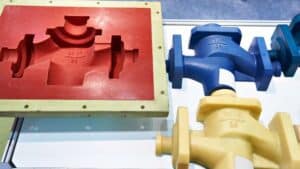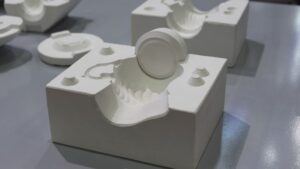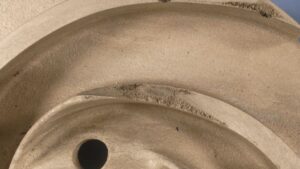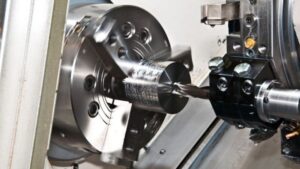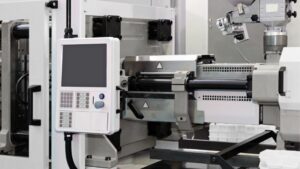A spotface is a machined area on a part that creates a flat, smooth surface for a fastener like a bolt or screw. It helps ensure proper contact and prevents damage to the part’s surface. Spotfacing is a common manufacturing technique used to improve the fit, function, and appearance of mechanical parts.
They can be found in many daily products. From car engines to household appliances, this simple but important feature helps ensure parts fit together correctly and stay secure. Without proper spotfacing, fasteners might not seat properly, leading to loose connections or damaged components.
Purpose of spotface
Spotfacing creates precision machined areas that serve critical functions in mechanical assemblies. These areas ensure proper component fit and distribute forces evenly across connection points.
Providing a Smooth Seating Surface
When a bolt or screw tightens against an uneven surface, it can create point loading. This uneven pressure distribution leads to stress concentration that may damage components or cause mechanical failure. Spotfacing creates a flat, clean area where fastener heads or washers can sit properly, and brings theses benefits:
- Even pressure distribution across the contact area
- Prevention of component warping during assembly
- Improved sealing capabilities for gasketed connections
- Reduction of surface imperfections that could cause misalignment
Also. spotfacing is suitable for cast parts where the as-cast surface is too rough for proper fastener seating.
Enhancing Fastener Stability
Spotfacing significantly improves fastener stability in mechanical assemblies. Creating a spotface hole means creating a perpendicular surface that helps maintain alignment and prevents tilting or shifting under load. Without it, bolts might not be able to be fastened due to uneven pressure distribution. Therefore, it can be concluded that the spotfacing boasts the following advantages:
- Resistance to vibration loosening
- Better load distribution
- Reduced risk of fastener bending or shearing
- Increased joint reliability in dynamic applications
Spotfacing is particularly important in high-vibration environments like engines or industrial machinery.
For critical applications, engineers often specify precise spotface dimensions to ensure optimal performance.
Machining Process of Spotface Hole
This operation uses specialized tools and precision cnc machining to cut circular areas to specific depths, ensuring components fit together correctly and distribute pressure evenly.
Common Tools Used for spotfacing
Spotfacing operations typically rely on several specialized tools. The most common is the spotfacer, which resembles a counterbore but has a pilot that guides the cutting portion.
These tools can be found in various configurations:
- Piloted spotfacers – Have a non-cutting pilot that fits into a pre-drilled hole
- Combination drill and spotfacer – Performs both operations in one step
- Interchangeable pilot spotfacers – Allow user to swap pilots for different hole sizes
CNC machines often use end mills for spotfacing operations when working with complex parts. For mass production, indexable insert cutters provide cost efficiency since user only replaces the worn inserts rather than the entire tool.
Typical Materials and Workpieces
Spotfacing works on most machinable materials, but the process varies based on material properties.
Common materials processed:
- Aluminum and aluminum alloys (soft, requires lower speeds)
- Steel and stainless steel (needs proper cooling)
- Cast iron (often machined dry)
- Plastics (requires sharp tools to prevent melting)
Typical workpieces include engine blocks, valve bodies, flanges, and structural components. It is commonly observed that spotfacing would be for parts that require mounting hardware or precise component interfaces.
The workpiece hardness determines cutting parameters. Softer materials allow faster feeds and speeds, while harder materials require slower machining to prevent tool wear and maintain accuracy.
Steps in the spotfacing Process
The spotfacing process follows a systematic approach to ensure accuracy and quality results.
- Preparation: Secure the workpiece firmly. For manual operations, mark the center point of the spotface location.
- Drilling: If not already present, drill a pilot hole slightly smaller than the pilot diameter of your spotfacing tool.
- Tool setup: Mount the appropriate spotfacer. For manual operations, set the depth stop to control how deep the spotface will be.
- Machining: Begin cutting by allowing the pilot to enter the pre-drilled hole, guiding the cutting edges. Apply cutting fluid if appropriate for the material.
- Finishing: Once the desired depth is reached, withdraw the tool and remove any burrs from the surface.
The finished result should be double-checked for proper diameter, depth, and surface finish before proceeding with assembly.
Applications of spotface
Spotfacing facilitates better contact for fasteners and components. This operation helps distribute pressure evenly and ensures proper assembly in various industries.
Mechanical Assembly
Spotfacing is essential in mechanical assembly where bolts, nuts, and washers need a place sit against. Spotfaces could be on engine blocks where they provide proper seating for cylinder head bolts. This ensures even clamping pressure and prevents leaks.
In automotive applications, spotfaces help maintain precise torque specifications on critical fasteners. Machinery frames often have them where vibration-sensitive components attach, as they can prevents components from shifting or becoming misaligned during operation.
There are also spotfaces in hydraulic systems where precise sealing is required. They helps gaskets and O-rings maintain proper compression.
Electrical and Electronics Enclosures
In electrical applications, spotfacing creates proper mounting surfaces for ground connections. They are needed to ensure good electrical contact between components and housings.
Electronics enclosures use spotfacing to provide flat areas for switches, displays, and control panels. This helps maintain proper alignment and prevents stress on delicate electronic components.
Weather-resistant equipment relies on spotfacing to create sealing surfaces. The flat areas allow gaskets to compress evenly, keeping moisture and contaminants out of sensitive electronics.
Cable glands attach in junction boxes contain spotfaces as well, which help maintain the integrity of environmental seals when cables enter enclosures.
Spotface vs. Counterbore and Countersink
Spotfacing, counterboring, and countersinking are three machining techniques that create recesses for fasteners, but they serve different purposes and have distinct characteristics. Each method has specific applications in manufacturing and engineering projects.
Key Differences
Spotfacing creates a flat, circular area on an uneven surface. It’s typically shallower than a counterbore and doesn’t necessarily go all the way through the material. The main purpose is to provide a smooth bearing surface for fastener heads or nuts.
Counterboring produces a flat-bottomed cylindrical hole . This recess is deeper than a spotface and designed to fully contain socket head screws or bolt heads below the surface. Counterbores have straight sides and precise dimensions.
Countersinking creates a cone-shaped depression that matches the angle of tapered screw heads (usually 82° or 90°). This allows flush mounting of flat head screws. Unlike spotface and counterbore, countersink hole has angled sides.
Here’s a quick comparison:
| Feature | Spotface | Counterbore | Countersink |
|---|---|---|---|
| Shape | Flat, circular | Cylindrical | Conical |
| Depth | Shallow | Deep | Variable |
| Purpose | Creates bearing surface | Recesses fastener completely | Seats tapered fasteners flush |
| Bottom | Flat | Flat | Angled |
When to Choose Each Technique
Use spotfacing when need a small, flat area on an irregular surface. This technique works well for creating seating surfaces for washers and bolt heads on rough castings or forgings. There is no need to recess them completely.
Choose counterboring when fastener heads need to be completely hidden below the surface. This method is ideal for applications requiring a clean appearance or when protruding parts would interfere with function. Counterbores can often be seen in precision equipment and consumer products.
Select countersinking when working with flat head screws that need to sit flush with the surface. This technique is perfect for applications such as furniture, aircraft panels, and areas where protrusions could cause injury or damage.
Frequently Asked Questions
How is spotfacing performed in machining?
By definition, spotfacing is conducted by using a set of tools to create a flat surface on a workpiece. The operation typically begins with the workpiece secured in a fixture or vise to prevent movement.
The spotfacing tool is mounted in a drill press, milling or CNC machine, then positioned perpendicular to the processing area. During operation, the tool bit applies controlled pressure as the rotating tool cuts away material to create the flat spot. The depth is carefully controlled to meet design specifications.
What type of tool is used for spotfacing?
Spotfacing tools are specially designed cutting tools with flat bottoms and multiple cutting edges. They typically have a pilot that fits into an existing hole to guide the cutting operation.
Most spotfacing tools are made from high-speed steel (HSS) or carbide for durability and wear resistance. The cutting edges are designed to create clean, flat surfaces with minimal chatter.
Some spotfacing tools have interchangeable inserts that can be replaced when worn, saving the cost of replacing the entire tool.
In engineering drawings, how is a spotface indicated?
On engineering drawings, a spotface is indicated using the corresponding symbol or callout, which looks like a circle with an extended “V” on the right side. This symbol appears next to the surface requiring spotfacing. The drawing will include “SF” or “SFACE” followed by the required diameter and depth measurements which are typically shown with leader lines pointing to the symbol.
What are the standard dimensions for spotfaces?
For spotface, the standard diameters typically range from 1.5 to 2 times the diameter of the hole they surround. This provides adequate bearing surface for fastener heads or washers.
In addtion, its depth is usually kept to a minimum—just enough to create a flat, clean surface. Common depths range from 0.02 inches (0.5 mm) to 0.125 inches (3.2 mm). Industry standards like ASME Y14.5 provide guidelines for its dimensions, though specific requirements may vary based on the application and design needs.
What is the difference between spotfacing and counterboring?
Spotfacing provide a flat area around an existing hole to provide a bearing surface. It’s typically very shallow and intended just to create a flat contact area.
Counterboring creates a larger counterbore hole that is diameter cylindrical and allows fastener heads to sit below the surface. Counterbores are usually deeper than spotfaces and have specific depth requirements.
What is the significance of the spotface symbol in technical diagrams?
The spotface symbol in technical diagrams immediately indicates to manufacturers that a specific area requires spotfacing. This ensures proper machining during production.
The symbol communicates critical information about where flat surfaces are needed for proper component assembly.
Without this symbol, manufacturers might miss the need for spotfacing, potentially leading to improper fastener seating, uneven load distribution, or assembly problems.

